Mechanotransduction Device Treats Small Bowel Syndrome 
|
By HospiMedica International staff writers Posted on 05 Jan 2022 |

Image: The Eclipse XL1 placed inside the shortened small bowel (Photo courtesy of Eclipse Regenesis)
A prototype spring-like device applies controlled force to expand healthy tissue in patients suffering from short bowel syndrome (SBS).
The Eclipse Regenesis (Menlo Park, CA, USA) XL1 is a small, compressed coil that is placed inside the small intestine, secured at both ends with plication sutures. The natural expansion and contraction of the intestine work against the resistance of the device, leading to a mechanical transduction that stretches the bowel. Over a two to three week period, the compressed coil device slowly expands to its relaxed state, stimulating new tissue growth in the treated segment, and ultimately expanding it to two to three times the segment’s original length (about four cm).
Once the process is complete, the chromic sutures dissolve, allowing the XL1 to pass through the body to be excreted. Treatment length varies, depending on the starting point (amount of small intestine), the end point (how much new intestine is needed) needed to reduce total parenteral nutrition dependence. Preclinical studies show successful lengthening of the bowel, no perforations, and no obstructions. The newly formed tissue looks and acts like normal intestinal tissue with regard to metabolic uptake and contractile function.
“The basic concept is similar to distraction osteogenesis, which orthopedic surgeons have used for years, applying distraction force to broken bone that will grow up to a millimeter a day,” said Andre Bessette, CEO and a co-founder of Eclipse Regenesis. “Patients with SBS have lost more than 50% of their small intestine, so they’ll need more than one device applied or more than one procedure. We are getting close to performing the first-in-human procedure, and we hope to eventually be able to perform this procedure completely endoscopically.”
SBS is a devastating condition where patients struggle to absorb life-sustaining nutrients from their diet. It typically results from intestinal resection due to necrotizing enterocolitis (NEC), which takes place when the lining of the intestinal wall becomes infected and dies. It can also result from birth defects, such as Gastroschisis, Volvulus, Hirschsprung’s Disease, Intestinal Atresia, and other congenital defects. Patients struggle to absorb life-sustaining nutrients from their diet, and many become reliant on total parenteral nutrition (TPN) to survive.
Related Links:
Eclipse Regenesis
The Eclipse Regenesis (Menlo Park, CA, USA) XL1 is a small, compressed coil that is placed inside the small intestine, secured at both ends with plication sutures. The natural expansion and contraction of the intestine work against the resistance of the device, leading to a mechanical transduction that stretches the bowel. Over a two to three week period, the compressed coil device slowly expands to its relaxed state, stimulating new tissue growth in the treated segment, and ultimately expanding it to two to three times the segment’s original length (about four cm).
Once the process is complete, the chromic sutures dissolve, allowing the XL1 to pass through the body to be excreted. Treatment length varies, depending on the starting point (amount of small intestine), the end point (how much new intestine is needed) needed to reduce total parenteral nutrition dependence. Preclinical studies show successful lengthening of the bowel, no perforations, and no obstructions. The newly formed tissue looks and acts like normal intestinal tissue with regard to metabolic uptake and contractile function.
“The basic concept is similar to distraction osteogenesis, which orthopedic surgeons have used for years, applying distraction force to broken bone that will grow up to a millimeter a day,” said Andre Bessette, CEO and a co-founder of Eclipse Regenesis. “Patients with SBS have lost more than 50% of their small intestine, so they’ll need more than one device applied or more than one procedure. We are getting close to performing the first-in-human procedure, and we hope to eventually be able to perform this procedure completely endoscopically.”
SBS is a devastating condition where patients struggle to absorb life-sustaining nutrients from their diet. It typically results from intestinal resection due to necrotizing enterocolitis (NEC), which takes place when the lining of the intestinal wall becomes infected and dies. It can also result from birth defects, such as Gastroschisis, Volvulus, Hirschsprung’s Disease, Intestinal Atresia, and other congenital defects. Patients struggle to absorb life-sustaining nutrients from their diet, and many become reliant on total parenteral nutrition (TPN) to survive.
Related Links:
Eclipse Regenesis
Latest Surgical Techniques News
- Minimally Invasive Endoscopic Surgery Improves Severe Stroke Outcomes
- Novel Glue Prevents Complications After Breast Cancer Surgery
- Breakthrough Brain Implant Enables Safer and More Precise Drug Delivery
- Bioadhesive Sponge Stops Uncontrolled Internal Bleeding During Surgery
- Revolutionary Nano Bone Material to Accelerate Surgery and Healing
- Superior Orthopedic Implants Combat Infections and Quicken Healing After Surgery
- Laser-Based Technique Eliminates Pancreatic Tumors While Protecting Healthy Tissue
- Surgical Treatment of Severe Carotid Artery Stenosis Benefits Blood-Brain Barrier
- Revolutionary Reusable Duodenoscope Introduces 68-Minute Sterilization
- World's First Transcatheter Smart Implant Monitors and Treats Congestion in Heart Failure
- Hybrid Endoscope Marks Breakthrough in Surgical Visualization
- Robot-Assisted Bronchoscope Diagnoses Tiniest and Hardest to Reach Lung Tumors
- Diamond-Titanium Device Paves Way for Smart Implants that Warn of Disease Progression
- 3D Printable Bio-Active Glass Could Serve as Bone Replacement Material
- Spider-Inspired Magnetic Soft Robots to Perform Minimally Invasive GI Tract Procedures
- Micro Imaging Device Paired with Endoscope Spots Cancers at Earlier Stage
Channels
Critical Care
view channel
Light-Based Technology to Measure Brain Blood Flow Could Diagnose Stroke and TBI
Monitoring blood flow in the brain is crucial for diagnosing and treating neurological conditions such as stroke, traumatic brain injury (TBI), and vascular dementia. However, current imaging methods like... Read more
AI Heart Attack Risk Assessment Tool Outperforms Existing Methods
For decades, doctors have relied on standardized scoring systems to assess patients with the most common type of heart attack—non-ST-elevation acute coronary syndrome (NSTE-ACS). The GRACE score, used... Read morePatient Care
view channel
Revolutionary Automatic IV-Line Flushing Device to Enhance Infusion Care
More than 80% of in-hospital patients receive intravenous (IV) therapy. Every dose of IV medicine delivered in a small volume (<250 mL) infusion bag should be followed by subsequent flushing to ensure... Read more
VR Training Tool Combats Contamination of Portable Medical Equipment
Healthcare-associated infections (HAIs) impact one in every 31 patients, cause nearly 100,000 deaths each year, and cost USD 28.4 billion in direct medical expenses. Notably, up to 75% of these infections... Read more
Portable Biosensor Platform to Reduce Hospital-Acquired Infections
Approximately 4 million patients in the European Union acquire healthcare-associated infections (HAIs) or nosocomial infections each year, with around 37,000 deaths directly resulting from these infections,... Read moreFirst-Of-Its-Kind Portable Germicidal Light Technology Disinfects High-Touch Clinical Surfaces in Seconds
Reducing healthcare-acquired infections (HAIs) remains a pressing issue within global healthcare systems. In the United States alone, 1.7 million patients contract HAIs annually, leading to approximately... Read moreHealth IT
view channel
Printable Molecule-Selective Nanoparticles Enable Mass Production of Wearable Biosensors
The future of medicine is likely to focus on the personalization of healthcare—understanding exactly what an individual requires and delivering the appropriate combination of nutrients, metabolites, and... Read moreBusiness
view channel
Philips and Masimo Partner to Advance Patient Monitoring Measurement Technologies
Royal Philips (Amsterdam, Netherlands) and Masimo (Irvine, California, USA) have renewed their multi-year strategic collaboration, combining Philips’ expertise in patient monitoring with Masimo’s noninvasive... Read more
B. Braun Acquires Digital Microsurgery Company True Digital Surgery
The high-end microsurgery market in neurosurgery, spine, and ENT is undergoing a significant transformation. Traditional analog microscopes are giving way to digital exoscopes, which provide improved visualization,... Read more
CMEF 2025 to Promote Holistic and High-Quality Development of Medical and Health Industry
The 92nd China International Medical Equipment Fair (CMEF 2025) Autumn Exhibition is scheduled to be held from September 26 to 29 at the China Import and Export Fair Complex (Canton Fair Complex) in Guangzhou.... Read more














